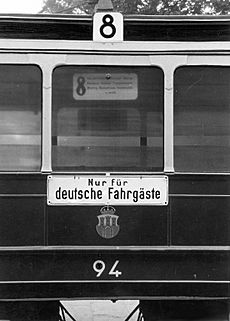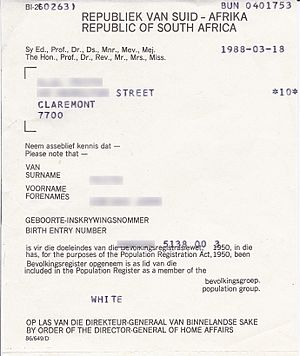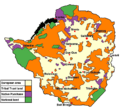Racial segregation facts for kids
Racial segregation means keeping people apart because of their race. This used to be legal and common in many countries for a long time. For example, in the United States, it was legal to separate white and African-American people until 1964 in some states. In South Africa, from the 1940s to the 1990s, a system called apartheid kept white and black South Africans separate. Racial segregation has happened in many other countries throughout history.
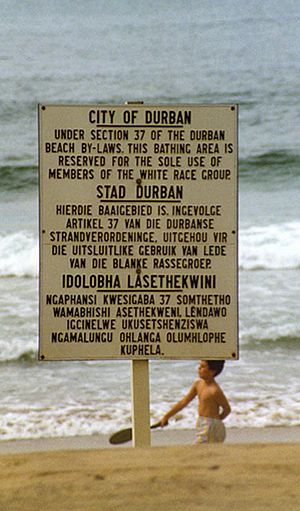
Segregation is not about having "separate but equal" places for different races. It happens when a country or society believes one race is better than another. The goal of segregation is to keep the "lesser" race away from the "better" race. People seen as "lesser" are often treated unfairly. They face discrimination. They might not have basic rights, like the right to vote. A United States Supreme Court judge once said that "separate facilities are [always] unequal."
Contents
Segregation in History
Anglo-Saxon England
Some historians believe segregation might have existed in early Anglo-Saxon England. When the Anglo-Saxons arrived in England around the 4th century, they might have created a society similar to apartheid. They may have treated the native British people like slaves. There might have been rules against marrying them. Some historians say Anglo-Saxons were much richer and had a higher social standing than Celtic Britons.
Australia
From the early 1800s to the late 1980s, the Australian government took many Aboriginal children from their families. Their families did not agree to this. The government wanted to force Aboriginal children to become part of Australian society. These children were placed in white homes or on missions. They were forced to learn Christianity and leave their Aboriginal culture behind. The goal was to make them part of white society and marry white people. This program aimed to remove Aboriginal traits from Australia. Later, in 1951, the United Nations called this type of program genocide.
From about 1900 to the 1970s, Australia had a "White Australia Policy." This policy stopped non-white people from moving to Australia. It made immigration tests too hard to pass for them.
In the early to mid-1900s, many Aborigines were forced to live on missions. The government wanted Aborigines off their lands so white settlers could use them.
In the 1960s, Australia changed its policy to "integration." This meant Aborigines had to live in Australian society or on missions. But many Aborigines refused and kept living far from cities. In these areas, they were separated from the rest of Australian society and were also poorer. Some people at the time called this situation "apartheid." They even thought Australia's policies might have inspired the apartheid program in South Africa.
English Settlers in Ireland
In 1366, the King of England passed thirty-five laws called the Statutes of Kilkenny. These laws aimed to stop English settlers in Ireland from mixing with the Irish people. They also wanted to prevent settlers from becoming too much like the Irish. The laws made it illegal for English people to marry native Irish people. It was also illegal to have or adopt Irish children, use Irish names or clothes, or speak anything but English.
French Algeria
In 1830, France took control of Algeria from the Ottoman Empire. For over a hundred years, Algeria was a French colony. The French rulers kept a system similar to apartheid in Algeria. For example, Arab and Berber Algerians could only apply for French citizenship if they gave up their Muslim religion and culture. Citizenship would give them the right to vote and other rights.
Algerian Muslims did not agree with this "system of apartheid." This system was a main reason for the Algerian War in 1954.
Germany
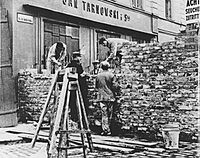
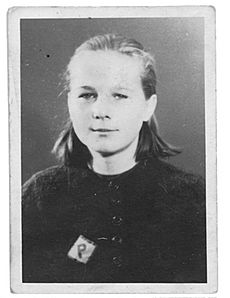
In the 1400s in north-east Germany, "Wendish" (Slavic) people were not allowed to join some guilds (worker groups). One writer noted that "into the 1700s no German guild accepted a Wend."
In 1935, after the Nazi Party took control of Germany, they passed the Nuremberg Laws. The Nazis, led by Adolf Hitler, believed the "Aryan" race was better than all others.
In 1939, the Nazis invaded Poland and took it over. They divided the Polish people into different ethnic groups. Each group had different rights based on how "Germanic" they were. For example, groups were allowed different amounts of food. They could only live in certain places and use certain public transportation.
During the 1930s and 1940s, the Nazis made Jews wear yellow ribbons or stars of David with the word "Jude" ("Jew") on them. Racial laws discriminated against Jews and Roma people (Gypsies). For example, Jewish doctors could not treat Aryan patients. Jewish professors could not teach Aryan students. Jews were not allowed to use most public transportation. They could only shop from 3:00pm to 5:00pm, and only in stores owned by Jews. They could not go to theaters, swimming pools, or other entertainment places.
During the Holocaust, the Nazis tried to kill all Jews and Roma in Europe. They also killed millions of Slavic people (including Ukrainian, Soviet, and Polish people). This was because they saw Slavs as a lesser race. First, the Nazis forced Jews and Roma to live in ghettoes, separate from everyone else. Then they sent millions of Jews, Roma, and Slavs to concentration camps and death camps.
Imperial China
Tang Dynasty
During the Tang Dynasty, the Han Chinese passed laws that separated non-Chinese people from Chinese people. In 779, the Tang Dynasty made a rule forcing Uighurs to wear their traditional ethnic clothing, not Chinese clothing. It also banned them from 'pretending' to be Chinese and from marrying Chinese women. The Han Chinese disliked Uighurs because they loaned money for interest.
In 836, when Lu Chun became governor of Canton, he was upset to find Chinese people living with foreigners and marrying them. Lu made segregation the law. He made it illegal for non-Chinese people to marry Chinese people or to own property. The law specifically banned Chinese from forming relationships with "Dark peoples" or "People of color." This included foreigners like "Iranians, Sogdians, Arabs, Indians, Malays, Sumatrans," and others.
Italy
In 1938, Italy was ruled by a fascist government led by Benito Mussolini. This government was allied with Nazi Germany. Under pressure from the Nazis, Italy passed laws that brought segregation to the Italian Empire. They called these laws 'norms for the defence of the race'.
These laws especially targeted Jews. For example, Jews could not:
- Teach or study in schools or universities
- Own important industries
- Work as journalists
- Enter the military
- Marry non-Jews
Because of these laws, Italy lost some of its best scientists. Some were fired. For example, Rita Levi-Montalcini, who later won the Nobel Prize in Physiology or Medicine, was told she could no longer work at her university. Others left Italy because of the laws. For example, Enrico Fermi, who worked on the first nuclear reactor and won the Nobel Prize for Physics, left the country because his wife was Jewish. Many other well-known scientists and scholars lost their jobs or left Italy due to these race laws.
Albert Einstein resigned from his honorary membership at an Italian science academy to protest the race laws.
After 1943, when Northern Italy was occupied by the Nazis, Italian Jews were sent to Nazi concentration camps and death camps.
Jewish Segregation
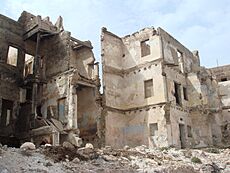
For centuries, Jews in Europe were often forced to live in separate ghettos and shtetls (small towns mostly for Jews). In 1204, the Pope ordered Jews to separate themselves from Christians. They also had to wear clothing that marked them as Jews. Forced segregation of Jews spread across Europe during the 1300s and 1400s.
In the Russian Empire, starting in the 1790s, Jews were only allowed to live in the Pale of Settlement. This was the western border area of the Russian Empire. By the early 1900s, most European Jews lived there.
In Morocco, starting in the 1400s, Jewish people were separated into mellahs. In cities, a mellah was a separate area for Jews, surrounded by a wall. Rural mellahs were separate villages where only Jews lived.
Latin America
When Spanish people came to the Americas and made Latin American countries into colonies, they created a caste system based on race. They had fifteen different categories of people based on their race mixtures. These included terms like "mulatto" and "mestizo". People who were "whiter" or more "Spanish" had a higher social standing. People who were "darker" or more Native American were treated as lesser. They faced discrimination. For example, they had to pay higher taxes than "whiter" people.
Usually, when they won their independence from Spain, most Latin American countries made laws against caste systems. However, prejudice based on race still exists.
South Africa
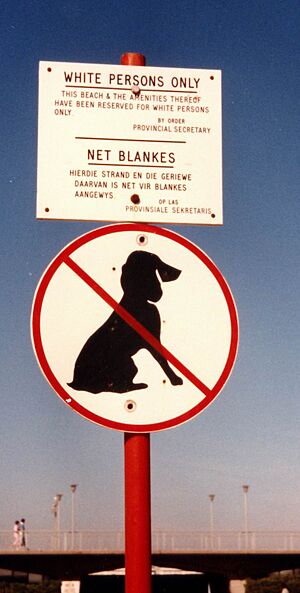
Background
Racial segregation in South Africa began when the country was a Dutch colony. The Dutch landed at Cape Town in 1652 and slowly took over more land. Segregation continued when the British Empire took over the Cape of Good Hope in 1795.
Slavery existed in South Africa until 1833. However, two years later, a law changed slaves into indentured servants. This system was very similar to slavery. Throughout the rest of the 1800s, the South African colonies passed laws that limited these workers' rights and freedoms.
In 1894 and 1905, the government passed laws saying that "Indians" and "blacks" had no right to vote. Other laws discriminated against non-whites, but they were not as harsh as the apartheid laws that came later.
Beginnings of Apartheid
Apartheid in South Africa started in 1948. At that time, the National Party won control of the South African government. This political party was made up of Afrikaner people. Afrikaners are the descendants of Dutch settlers who came to South Africa in the 1600s and 1700s. The National Party believed in Afrikaner nationalism. Soon, they started a program of apartheid. This word means "apart-hood" or 'being separate' in the Afrikaans language.
The goal of apartheid was to keep non-white people separate from whites in economic, political, and social ways. This meant the National Party did not want non-whites to have the same social standing as them. They did not want non-whites to vote or be part of the government. They also did not want non-whites to live or work near whites. They even kept them from going to schools, beaches, parks, or other places that whites used.
Apartheid Laws
The National Party passed apartheid laws to make racial segregation legal in South Africa. Some of the most important laws included:
- The Population Registration Act (1950): This law put South Africans into four racial groups. These were "black," "white," "Colored" (mixed-race), and "Indian" (South Asians).
- People had to register with the government. They got identification cards that showed their racial group.
- The Group Areas Act (1950): This law assigned a part of South Africa for each racial group to live in. People were forced to live in their assigned area.
- The Reservation of Separate Amenities Act (1953): This law created separate public places for different races. These included hospitals, universities, and parks.
- The Bantu Education Act (1953): This law separated education by race.
Under these apartheid laws, from 1960 to 1983, 3.5 million non-white South Africans were forced to leave their homes. They had to move into segregated neighborhoods. This was one of the largest forced removals in modern history.
Other laws made it illegal for a person to marry someone from a different race. Then, in 1969, the government took away "Coloured" people's right to vote. Since "Indians" and "blacks" had not been allowed to vote for decades, this meant only whites could vote in South Africa.
In 1970, non-whites were banned from having representatives in the government. That same year, black people's South African citizenship was taken away.
Protests
Protests against apartheid began right after it started. As early as 1949, the youth wing of the African National Congress (ANC) suggested fighting racial segregation in many ways. Over the next 45 years, hundreds of anti-apartheid actions took place. These included protests by the Black Consciousness Movement, student protests, labor strikes, and church group activism.
In 1991, the Abolition of Racially Based Land Measures Act was passed. This law reversed laws about racial segregation, including the Group Areas Act. In 1990, President Frederik Willem de Klerk started trying to end apartheid. Non-whites were given the right to vote in 1993. South Africa had its first multiracial elections in 1994, where non-whites could be candidates. Nelson Mandela and the African National Congress won.
United States
The United States has a long history of racial segregation. It started when the first European settlers came to North America. First through slavery, then through racist laws, and then through racist attitudes, African-American people in the United States have faced segregation for centuries. People of other races have been segregated too. For example, during World War II, President Franklin D. Roosevelt ordered almost all Japanese-American people to be segregated in internment camps.
People of all races have fought against segregation and discrimination in the United States. Thanks to movements like the African-American Civil Rights Movement, segregation is now against the law in the United States. However, prejudice against minority groups still exists. This has led to new types of segregation caused by people's prejudices and behavior.
Images for kids
-
"We Cater to White Trade Only" sign on a restaurant window in Lancaster, Ohio, in 1938. In 1964 Martin Luther King Jr. was arrested and spent a night in jail for attempting to eat at a white-only restaurant in St. Augustine, Florida
-
White tenants seeking to prevent Blacks from moving into the housing project erected this sign. Detroit, 1942
-
Rosa Parks being fingerprinted after being arrested for not giving up her seat on the bus to a white person.
-
A barrier gate at Bil'in, West Bank, 2006
See also
 In Spanish: Segregación racial para niños
In Spanish: Segregación racial para niños


